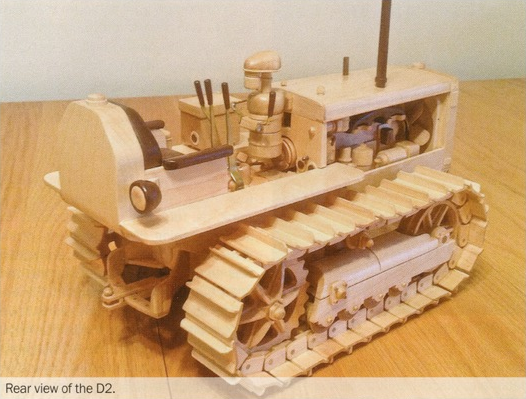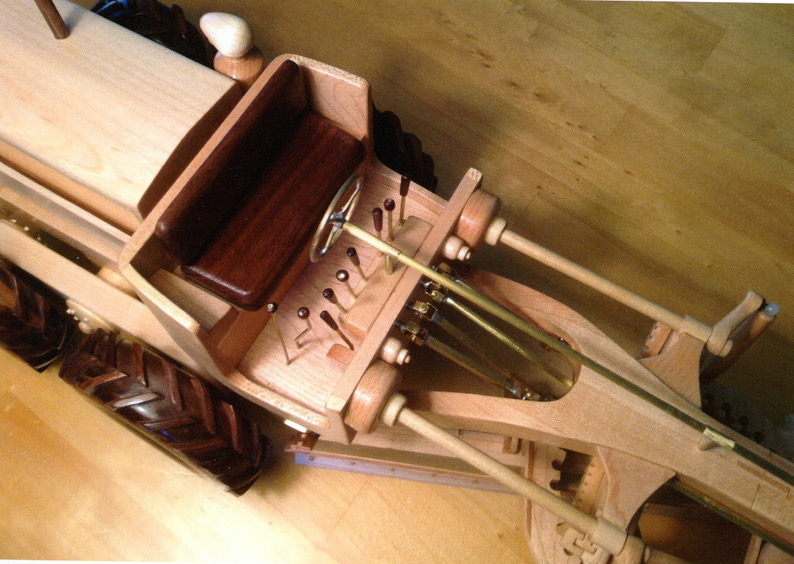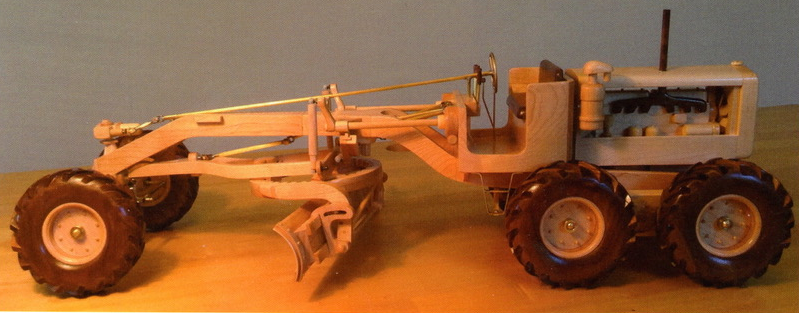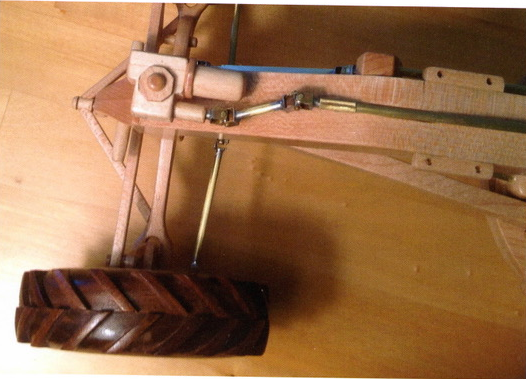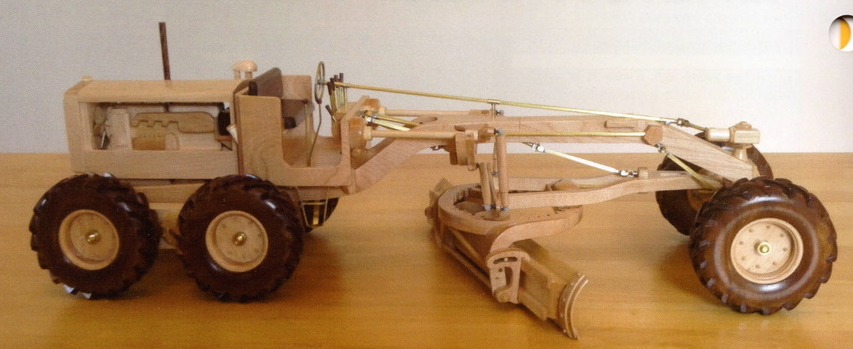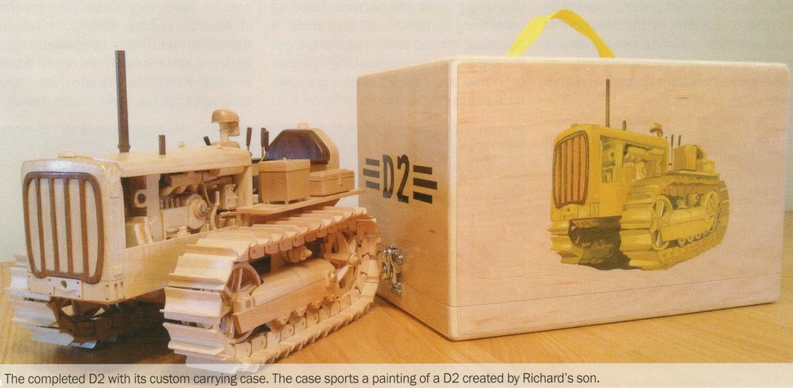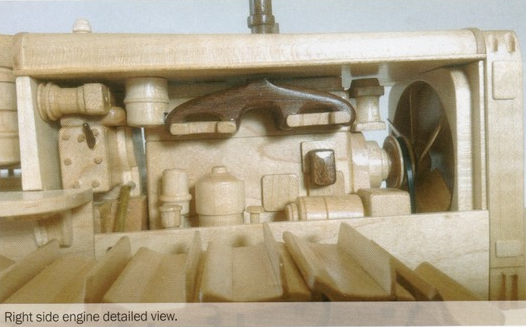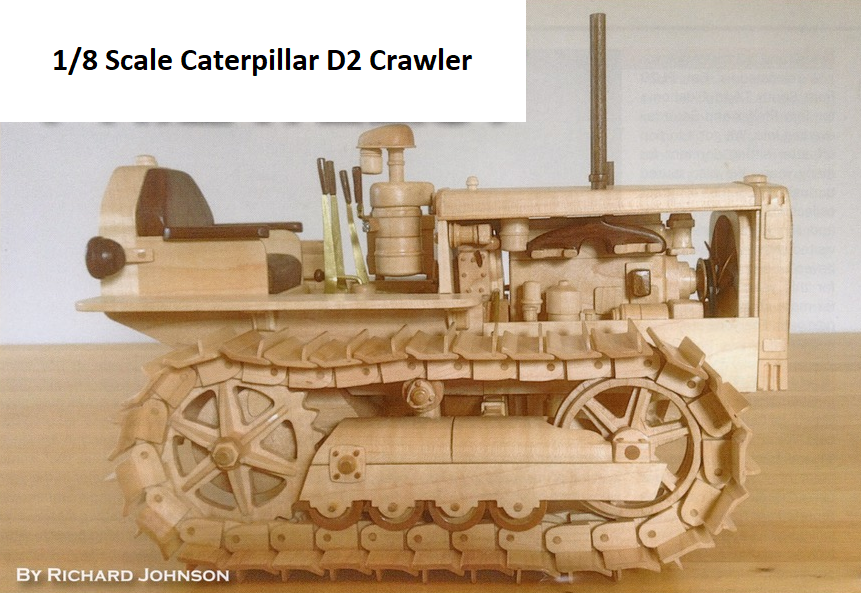Scale Model Caterpillar Equipment Brought to Life Through Woodworking
Introduction
The following information was submitted by Richard Johnson, along with excerpts pulled from two of his articles published in the Antique Caterpillar Machinery Owners Club’s (ACMOC) quarterly magazine.
Richard Johnson, of Los Angeles, CA has been fascinated with Caterpillar tractors since he was a youngster. To him, there is something about the machines that seem to set them apart from other heavy equipment manufacturers.
Specifically, Richard wrote, “I think it’s the shape of the engine compartment, which is really nothing more than a stationary engine mounted onto a frame, that I find attractive.” He’s not alone, either, as Richard has found a community of Caterpillar enthusiasts in the Antique Caterpillar Machinery Owners Club (ACMOC). In fact, it was partly through excursions with his ACMOC chapter that Richard began to feel inspired to build a Caterpillar of his own.
In retirement, Mr. Johnson came across a set of plans for a wooden toy excavator and decided to build it. Despite some setbacks when making the tracks, the model came out nicely. This model lead to another, and eventually Richard decided to make a small scraper from a set of plans, which he would modify to his liking. However, it was during this time that Richard had a change of heart. After seeing two vintage Cat No.12 graders at the Antique Gas and Steam Engine Museum, he decided that he would in fact build one of those instead.
The model grader project went far beyond any of Richard’s expectations as he strove to build the most authentic wooden replica possible. Little did he know that those first model kits would lead him on a years long journey to build not one, but several scratch-built museum quality wooden Caterpillar models.
The actual No.12 Grader has been in production for over 75 years. This model represents the 12E, which was made from 1959 to 1964.
Building an Authentic Caterpillar Grader
On his desire to build a better model, Richard had this to say, “I’ve always loved realistic toys. They had to look like the real thing and had to work like the real thing. I never owned a Tonka truck for that reason; they looked like a Tonka toy, nothing else. I was determined my grader would look like a real one and be proportionate. The front wheels had to lean. The blade had to operate properly. It had to steer.” Without plans, Richard started taking photos of real graders whenever and wherever he got the chance.
He also had a 1/24 scale model by Ruehl that proved to be an accurate representation to work from. However, with more progress Richard found that he was still missing bits and pieces of information and specs. Through many visits to the Antique Gas and Steam Engine Museum, and constant updates to his blueprints, Richard finally gathered all the measurements and photos needed to build his Grader.
Shown here are a variety of scratch-built wooden parts for the 1/12 scale model Caterpillar No.12 Grader. The model was primarily made from maple with some walnut for the lighter spots.
From conception to completion, the project took 18 months. Richard noted, “My model is 1/12 scale and totally scratch built. It is about 26 inches long and made out of maple, with walnut used for the tires, manifold, and control knobs. The drive shafts, steering wheel, and control levers are brass. The finish is clear glass lacquer. I bought a few ball and socket units from a model shop for the blade hangers.”
The construction process was no small feat. It took Richard days, sometimes weeks at a time to figure out certain aspects of the machine. In particular, he noted that the wheel lean was incredibly challenging to work out. He noted that in addition to leaning, the wheels have to steer and the axle has to pivot—sometimes all at once. Richard spent days just trying to study this aspect of the grader, let alone building it in miniature.
The full-size Caterpillar No.12 Grader has been in production for over 75 years. While the configurations have changed over time, Richard’s 1/12 scale model is a 12E, which was produced from 1959 to 1964. The unique design of the front wheels on a non-driven axle provides self-cleaning properties of the angled rubber cleats in the tires.
Read Richard’s full article on the construction of his 1/12 scale grader.
A New Model Brings Novel Challenges
After building his scale model grader, Richard set his sights on another project. Though he confessed to be attracted to machinery of all types, Richard noted that he is particularly fond of heavy equipment, “the workhorses,” as he says. When it came time to start building a new model, Richard recalled, “The Caterpillar D2 caught my eye many years ago, I toyed with making one out of wood for a long time and was determined to make the tracks look like the real thing.
Richard decided that if he couldn’t get the tracks right, then there was no need to finish the model because it wouldn’t look authentic. Generic tracks simply would not do for this model, so he needed a solution. Then, one night Richard had an epiphany and worked out a plan in his head. He would shape overlapping track pads with the tablesaw and router. Richard tested his method the next day and had immediate success, so he drove forward.
Richard noted that the basis for his own D2 model was a 1/16 scale diecast model of the machine that was issued by ACMOC. He found that the dimensions he took from real tractors matched up quite well with those on the scale model, so he could rely on its accuracy. Just as he had for the crawler model, Richard spent many trips taking photographs of real D2 tractors and recording all kinds of dimensions.
However, Richard remarked that, “Other than that, I had no master plan drawn up. I am neither draftsman nor artist and really pay the price for those failings. I did try to draw indivdual parts with some degree of success. Basically this was a piecemeal process of trial and error where I’d make a part over and over until it came out right.”
The process of trial and error paid off in the end, but not without some bumps in the road. Richard had to restart several processes along the way, and also needed to decide what details he might include on his sizable model. The D2 is about 13″-long, 8″-wide, and 10″ to the top of the stack.
Commenting on some of the details, Richard said, “The track pads weren’t that difficult to make but, dang, there are so many of them and each one needed to be machined, deburred, and sanded smooth.”
Then came the issue of linking them all together, which was another ordeal all its own. But with the tracks eventually made, Richard was fully committed to building the entire model. He joked that there was no turning back now that he had told many of his friends about the endeavor. With the real challenge ahead of him, Richard set out to make the drive sprockets, front idler, and eventually the chassis. The chassis proved difficult given that the original was made of castings that blend into each other.
Continuing on, Richard recalled, “After I finished the chassis I moved on to the undercarriage, radiator, engine compartment, and cockpit. What I ended up with was a bunch of separate projects cobbled into the finished product.” But the process was slow and tedious, and called for a lot of reworking.
After consulting with owners of the real tractor and adjusting his model accordingly, Richard was slowly able to get his crawler looking fully authentic. The entire model tractor was scratch-built from maple, with some walnut details and brass for delicate parts.
On the final construction, Richard noted, “The finish is clear lacquer. I don’t like to use a whole bunch of different exotic woods because I believe it only distracts from a model. My opinion is that it’s better to keep it simple and let the design speak for itself rather than show off how many different kinds of wood you can name.”
Richard added that he doesn’t use CAD, CNC, 3D printing, or even miniature tools for that matter. He believes that there is no substitute for human touch, especially when it comes to model making.
With his finished Caterpillar D2, Richard reflected, “This model was difficult. I’m not sure if it was a labor of love but I built it of my own volition and no one twisted my arm to make it. I literally spent hours just staring at it on my workbench trying to figure out how to proceed.”
“I like making jigs and fixtures for my power tools and let them do the work, but detest handwork and will never be a woodcarver. I dreaded making things like the manifolds that had to be shaped with a rotary grinder (Dremel), files, and sandpaper.”
“On the other hand, I do enjoy the process of solving problems and the finished product fills the vision I had when I began. So here we are. Am I pleased with the result? Yes. Does it roll nicely? Yes. Are these some mistakes? Yes. Will I make another one? No.”
The real D2 Crawler was made from 1938 to 1957. Richard’s 1/8 scale model replicates a D2 5U from the early 1950s. Read Richard’s full article on the construction of his Cat D2.
What’s Next?
After finishing his 1/12 scale model Caterpillar No.12 Grader and his 1/8 scale Caterpillar D2 Crawler, Richard decided to build a scale model implement for the D2. It’s called a Cat No.1 Terracer, and it was originally produced from 1931 to 1942.
The implement was made to be towed by a tractor. Richard’s 1/8 scale terracer has a blade similar to the grader, but it wasn’t used for leveling. Instead, the terracer was used to shape the land for soil conservation and erosion control.
Mr. Johnson was gracious enough to loan his impressive scale model Caterpillar heavy equipment to the Miniature Engineering Craftsmanship Museum for an extended period, where visitors could admire the fine woodworking and engineering themselves. The models have since been returned to Richard, who is in the process of building a new model for his wooden Caterpillar collection. We thank Mr. Johnson for sharing his fine craftsmanship with the museum, and we look forward to seeing what he makes next!

